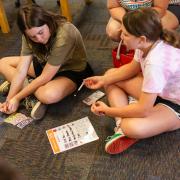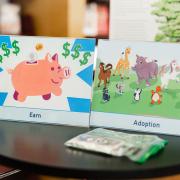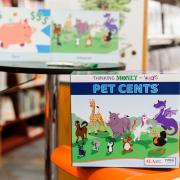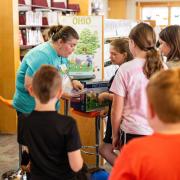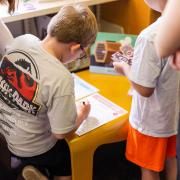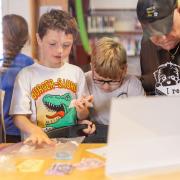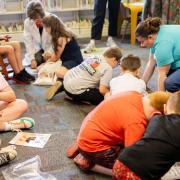Players adopt a pet — and take on the financial responsibilities of pet ownership — as they visit various stations around the room. At each stop, players engage in financial transactions with an assistant/cashier (i.e., an adult or older kid), spending and receiving money until the timer runs out. Along the way, they are faced with unexpected events that could result in a financial windfall or expense. All transactions are tracked on the player’s Pet Card. The goal of the game is to meet a pet’s needs while retaining as much money as possible.
Pet Cents is part of the Thinking Money for Kids Program Kits, an initiative of the American Library Association (ALA) and the FINRA Investor Education Foundation. Thinking Money for Kids strives to teach children and their parents, caregivers and educators about financial topics — like saving, spending, sharing and budgeting — in a way that is both meaningful and fun.
Advanced Planning
Learning Goals
- Understand what a budget is and how it is useful
- Think about what it means to be financially responsible
- Identify essential expenses (food, housing, healthcare)
- Cope with unexpected financial needs
Preparation
All game materials needed (including instructions, station signs/menus, Pet Cards, Event Cards, Earn Cards, facilitator's script, play money, and Pet Cents Champion certificate) are available in the Attachments section below. Besides those materials, you will also need 10 dry-erase markers, six tables or chairs (to designate each of the 6 stations), and a timekeeping device.
All materials should be printed off and ready in advance. I also recommend reading the instructions and facilitator's script in advance and, if possible, playing a practice round of the game with volunteers or staff.
Marketing
The program was advertised through the library's online calendar, featured in a story block on the library's homepage and posted to social media. Our patrons know to check those three locations and help spread the word by sharing the information and tagging other people who might be interested.
Budgeting
Cost would be incurred through printing off the needed materials. Otherwise, there shouldn't be any cost.
Day-of-event Activity
Before participants arrive, set up six stations around the room: (1) Pet Adoption Center, (2) Earn Station, (3) Vet’s Office, (4) Food Store, (5) Pet School, and (6) Pet Supply Store. Each station is designated by a table/chair and a tabletop sign and is staffed by one library employee or volunteer.
Pet Adoption Center: Set out the Pet Cards, dry-erase markers, and play money in stacks of $150.
Earn Station: Set out Earn Cards and play money.
Vet’s Office, Food Store, Pet School, and Pet Supply Store: Place the corresponding Station Cards. Before the program begins, provide instruction sheet to the library staff or volunteers who are staffing the stations.
This game will work best if you have 6 staff and/or volunteers to help man the various stations and assist participants with adding and subtracting their purchases. The program facilitator can double as the Adoption Center assistant.
Pet Cents will accommodate 5–10 kids, or up to 20 kids if they work in pairs. Working in pairs can also be helpful if there is a wide age-range of participants.
The entire program will take about 30 minutes.
Program Execution
Players start by visiting the Adoption Center, where they (1) receive a Pet Card, a dry-erase marker, and $150 in play money, (2) pay their pet’s adoption fee, and (3) name their pet.
Once all the players have adopted a pet, the facilitator sets a timer for 15–20 minutes. For the remainder of the game, players take their remaining money and walk to the Vet’s Office, Food Store, Pet School, and Pet Supply Store (in any order) to buy things their pets need or want.
At each station, assistants exchange players’ money for goods or services and update their Pet Card. Players can choose between three different items for their pet at each station, and they should visit each station at least once during the allotted time.
Every few minutes, the facilitator rings a bell or calls out “FREEZE!” Gameplay pauses while the Event Card is read and transactions take place.
An Event Card may have a positive or negative financial impact on a player. For instance, an Event Card might read, “Minus $10 to all pets that have not been to the vet.” The facilitator reviews players’ Pet Cards to see who is impacted and exchanges money as appropriate.
Players update their Pet Card with their windfall or expense. The facilitator may decide how many Event Cards to read and when, up to three times per game.
If participants run low or run out of money, they may visit the Earn Station, where they will draw one Earn Card. Each player may visit the Earn Station up to three times per game. The Earn Cards must be tallied on participants’ Pet Cards. Earn Cards should be returned to the deck after drawing, as they will be reused throughout the game.
Warn participants as the end of the game approaches. Count down and end the game.
Participants count how much play money they have at the conclusion of the game. Participants reconcile their completed Pet Cards with the amount of play money they have on hand. Assistants may help participants do the math.
Participants are eligible to be Pet Cents Champions if they have met all of the following criteria:
- They have fulfilled their pets’ needs by making purchases at each station (Vet’s Office, Food Store, Pet School, and Pet Supply Store).
- Have play money left over at the end of the station rotations.
- Have reconciled the amount of play money on hand with the amounts on the back of their completed Pet Card.
Advice
- Make premade kits:
- Creating kits with the Pet Cards, dry-erase marker, and starting cash ($150) in a reusable container makes program set up and the initial start of the game easier and less chaotic.
- With larger crowds (such as afterschool programs), we removed the adoption fee from the premade kits prior to the program start to prevent a backlog at the adoption center.
- Offer some assistance with math:
- We have seen kids (and adults) struggling with how the pet card budget tracker works, so we created an example that includes step-by-step instructions for completing the process. It's also helpful to review this cheat sheet with those helping you at the stations, so they are clear on the process and can step in to help.
- We have seen kids (and adults) struggling with how the pet card budget tracker works, so we created an example that includes step-by-step instructions for completing the process. It's also helpful to review this cheat sheet with those helping you at the stations, so they are clear on the process and can step in to help.
- Bring in a real-life pet, if possible:
- We always invite our Therapy Dog, Rudy, and his handler, Ellen, to our Pet Cents Programs. Rudy & Ellen man the Pet School station during the game then are available for the kids to Read with Rudy as one of our rotation stations to make the program last a full hour.
- Inviting the kids to bring a picture of their pet and share one cool fact really sets the stage for the game and asking them what they learned during the game to help them better care for their pet connects what they’ve learned to their real life.
- Rotation Stations: We always have 1-3 extra stations with activities that continue that week’s learning theme.
- For Pet Cents, we have successfully used the following rotation stations:
- Reading with Rudy: participants have the opportunity to read with Rudy (this is an on-going program where they can earn prizes).
- LEGO® Build a Pet: participants can build the pet they had in the game, build their favorite pet, or build an entirely unique animal.
- Adopt a Stuffie: participants are able to adopt a donated stuffie and are given an adoption certificate.
- Pet themed Goodie Bags: we had many leftover animal themed prizes such as color-your-own animal paddle ball games, Clifford light-up wands, pawprint bracelets, dog bone shaped candies, etc. that we allowed kids to “purchase” and fill up their bags.
- For Pet Cents, we have successfully used the following rotation stations:

